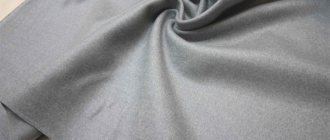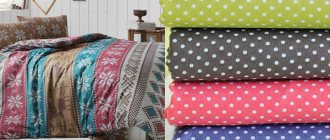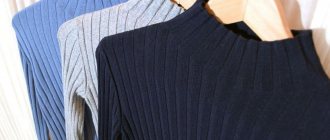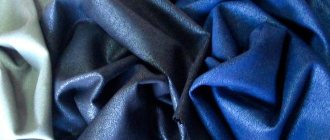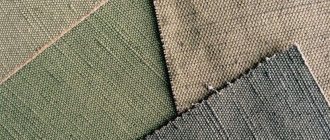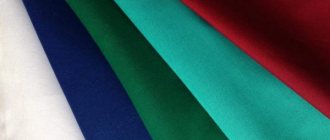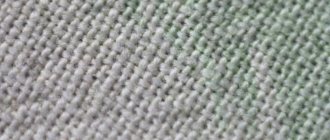Hygroscopicity
Hygroscopicity is the ability of fabrics to absorb water vapor and moisture in contact with the surface of the material, and then transfer them to the environment. In this case, the volume of sorbed moisture directly depends on the structure of the fabric fibers. For example, with a relative atmospheric humidity of 65% and an ambient temperature of 20°C, the hygroscopicity of woolen fabrics is 17%, cotton - 12-18%, linen - 12%, silk - 11%, nylon - 3%.
Why is hygroscopicity so important? The fact is that it has a serious impact on maintaining thermal balance, which is formed in the “person-clothing” system. This is explained by the fact that the presence of moisture increases the thermal conductivity of the material, since the thermal conductivity of water is an order of magnitude higher than the thermal conductivity of air. This factor is why a person freezes much faster in wet clothes than in dry clothes. The level of hygroscopicity of fabrics is of particular importance in cases where it is planned to sew workwear or produce sportswear.
Thermal protection
The ability of clothing to retain the heat generated by the human body is commonly called thermal insulation. Thermal protection characteristics are given attention even at the clothing design stage. To do this, a number of properties of the formed heat-protective package are analyzed: air permeability and thickness of fabrics, the overall thermal resistance of the package, design features of clothing, the structure of the materials used. At the same time, the key characteristic on which the efforts of clothing creators are focused is the thermal resistance of finished products. This parameter essentially represents the reciprocal of thermal conductivity.
The thermal resistance of clothing depends on the fiber structure of the fabrics, the thickness and number of air layers. Obviously, this is a heterogeneous value that differs for different types of products. The highest heat protection parameters are for garments made from thick and dense fabrics with pile or fleece. Clothes made of wool, yarn, lavsan and nitron fibers also have high heat protection.
The use of dense and thick fabrics in the construction of clothing leads to weighting of the products, which in turn negatively affects a person’s motor activity. This can significantly worsen the popularity and economic performance of manufactured clothing. Therefore, manufacturers are trying to design a thermal protection package from fabrics that have the best parameters of thermal resistance, vapor permeability, density and weight.
Heat protection package
The most rational option is considered to be a four-layer heat-protective clothing package, in which its functions are clearly defined for each layer:
1.Top
The outer fabric creates the external design of the clothing, and also forms the required characteristics of wear resistance, strength, resistance to stains, wrinkle resistance, and ease of cleaning. In addition, the key function of the upper material is to provide the necessary parameters for moisture and air tightness. This is of great importance for creating an optimal gas-humidity structure of the air under clothes.
2.Windproof pad
Windproof fabrics must provide the required level of breathability. In addition, their task is to form a certain strength and rigidity of the layer, which is necessary for the stability of the product against mechanical stress. The level of optimal breathability should not reduce the thermal protection of clothing, and it largely depends on the intended operating conditions. An example is the sewing of windbreakers for sports and the production of ordinary jackets, where the requirements for the breathability of the windproof lining will be different.
3.Insulating lining
This layer is mainly responsible directly for the heat-protective function. Lining fabrics must have a certain thickness, low bulk density and some elasticity. All this will ensure good heat retention due to the high air content in the layer. A sufficient level of moisture conductivity is also important so that moisture can freely leave the air underneath.
4.Bottom lining
The bottom lining is made of durable, wear-resistant and lightweight fabrics with a smooth surface. The material should be characterized by minimal electrification, as well as a color design that is in harmony with the color of the top.
The thermal protection characteristics of clothing depend significantly on its design. To protect the underwear space from the cool outside environment, elements such as wristbands on the sleeves, a one-piece hood closed to the top of the gate, and a belt at the waist can be used. However, it must be remembered that clothing of an excessively closed design significantly impairs the ventilation of the air under clothing. Ideally, clothing production should be carried out taking into account the needs of the population living in certain climatic zones.
Physical properties of fabrics
The ability of fabrics, knitwear and non-woven materials to pass air , steam, water, various liquids, smoke, dust, radioactive radiation is called permeability.
The breathability of a material is its ability to allow air to pass through. The air permeability coefficient of a material shows the amount of air passing through 1 m2 of fabric, knitwear or non-woven material in 1 second at a certain pressure difference on both sides of the material and is determined by the formula:
where V is the volume of air passing through the material at a given pressure difference Δр in m3; F is the area of the material in m2; t is the time it takes for the air to pass, in seconds.
The value of the air permeability coefficient depends on the pressure difference on one and the other side of the material, therefore, comparison of air permeability is made at a certain pressure difference, which is indicated by a digital index when designating the air permeability coefficient. The relationship between the air permeability coefficient ВΔр and pressure Δр can be expressed by the formula:
where Ap is the pressure difference behind and in front of the material in mm of water. Art.; ВΔр—air permeability coefficient in m3/m2 sec; a and b are coefficients determined experimentally and depending on the structure and thickness of the fabric.
Under operating conditions of clothing, a pressure difference can arise either under the influence of the temperature difference between the air under the clothing and outside, or under the influence of wind. The air permeability of both clothing materials and bags made from them is most often determined at a pressure difference P = 50 n/m2 (5 mm of water column), which corresponds to a wind speed of 8–10 m/sec, and is designated B50. The pressure difference depending on the wind speed is determined by the formula that is used in aerodynamic calculations:
where v is the wind speed equal to 8 m.1 sec; h is the pressure difference in N/m2 mm water. Art.
In table 11-11 shows the grouping of fabrics by breathability.
Table 11-11. Grouping fabrics by breathability.
| Fabric groups | Fabrics | General characteristics of the breathability of fabric groups | Air permeability in ml/cm2-sec | |
| at a pressure of 1 mm water. Art. | at a pressure of 5 mm water. Art. | |||
| 1 | Thick drapes and cloth, very thick cotton fabrics, diagonal, brushed cloth | Very small | Less than 1 | Less than 50 |
| 2 | Suit wool fabrics, diagonal, cloth and drape of high porosity and low volumetric weight | Small | 1—3 | 50—30 |
| 3 | Linen, dress, demi-season, light suiting fabrics | Below average | 3—10 | 135—375 |
| 4 | Lightweight linen and dress fabrics | Average | 10—30 | 375—1000 |
Continuation of the table. 11-11
| Fabric groups | Fabrics | General characteristics of the breathability of fabric groups | Air permeability in ml 1cm2-sec | |
| at a pressure of 1 mm water. Art. | at a pressure of 5 mm water. Art. | |||
| 5 | The lightest dress fabrics with large through pores (marquisette, aster), sports fabrics | Increased | 30—50 | 1000—1500 |
| 6 | Gauze, mesh, canvas, knitwear, etc. | Higher | More than 50 | More than 1500 |
The air permeability determined at a constant pressure difference also depends on the structure of the material, which determines the presence of through pores. The number, shape and size of pores affect the resistance a material provides to the flow of passing air. The number of through pores n in the fabric is determined by the product of density per 1 cm based on P0 warp and density per 1 cm based on weft Pu:
The average size of each pore can be determined by the formula:
where F is the total pore area in the fabric in mm2.
Below is data on changes in the breathability of fabrics depending on the pore area .
| Pore area in fractions of tissue area | Air permeability in ml/cm2-sec at a pressure of 3 mm water. Art. |
| 0,61 | 460 |
| 0,54 | 383 |
| 0,44 | 293 |
| 0,33 | 194 |
With the same pore area, the air permeability of materials can be different. Air, under the influence of a pressure difference, seeps through the fabric, doing work. Part of the work is spent on friction of air against the fabric, part - on overcoming the inertial forces of the external environment. The smaller the pores, the greater the friction of air against the fabric.
Therefore, with the same total pore area, the air permeability of fabrics and knitwear made from thin threads with small pores is less than the air permeability of materials with large pores. In fabrics and knitwear made from loosely twisted, loose fluffy threads, the pores between the threads are partially closed by fibers protruding from the threads, but if the threads are tightly twisted, the pores remain through. Therefore, fabrics and knitwear made from smooth, highly twisted threads have greater breathability.
Fabrics with the most compact structure are the least breathable. Thus, the air permeability of weaves such as twill, satin and finely patterned is greater than that of plain weaves, all other things being equal. As the length of the overlap increases, the structure of the fabrics becomes looser and their breathability increases. In brushed or felted fabrics, where the through pores between the threads are filled with fibers, air permeability depends on the thickness of the fabric and the looseness of its structure. The air permeability of raw fabrics is greater than that of finished, boiled and dyed fabrics, and especially of finished and pressed fabrics.
The air permeability of thermal protective clothing is a negative factor, since it reduces the thermal resistance of clothing, but at the same time, air permeability is of hygienic importance, since it provides natural ventilation of the underlying air when wearing clothing, which is especially important for summer and sportswear. In addition to the presence of through pores, thickness, volumetric weight and pressure difference, air permeability is also influenced by factors such as humidity and the number of layers of material in clothing.
The air permeability of the material decreases with increasing humidity. The greatest decrease in air permeability is at Δр = 5 mm water. Art. observed at a humidity of about 80% (Fig. 11-58). The decrease in breathability is explained by the filling of the fabric pores with moisture and swelling of the fibers. Increasing the number of layers of material reduces the overall breathability of the garment package.
Rice. 11-58. Dependence of fabric breathability on its humidity: 1 - cloth art. 4412; 2 - drape art. 3608; 3 — beaver art. 5714
Research shows that the most dramatic decrease in breathability (up to 50%) is observed when the number of layers is increased to two. A further increase in the number of layers of material affects the decrease in air permeability to a lesser extent.
Rice. I1-59. Change in the breathability of fabrics depending on the number of layers : 1 - drape art. 3608; 2 — cloth art. 4412
The air permeability of fabrics folded in several layers is determined using the equation:
where B is the air permeability of fabric folded in several layers, in ml/cm2-sec;
Vp is the air permeability of each layer separately in ml/cm-sec.
The air permeability of fabrics, knitwear and nonwoven materials is determined using devices that operate on the principle of creating a certain pressure difference on both sides of the sample, as a result of which air moves through the sample. The most widely used devices are those in which a vacuum is created in a chamber coated with the material being tested using a suction pump or fan.
- Back
- Forward
Permeability
The permeability of materials is the ability to allow air, moisture, liquids, dust, light, smoke, etc. to pass through. When it comes to clothing fabrics, the key parameters include breathability, vapor permeability, water permeability, dust permeability and light permeability.
Breathability
The breathability of fabrics is extremely important for the exchange of air in the underwear space with the atmosphere of the external environment. The fact is that the composition of the air under clothing always differs from the atmospheric air, since it is influenced by gaseous secretions of the skin and contamination of clothing. The supply of fresh air to the body helps remove carbon dioxide, which can have a negative impact on a person’s well-being. Therefore, clothing must be sufficiently ventilated.
The level of breathability of clothing depends on the fibrous structure of the fabrics, the number of layers used in the bag and its humidity. Increasing the number of layers significantly worsens the overall breathability of clothing. If we talk about individual types of clothing assortment, then the maximum breathability is characterized by clothes from the dress and underwear assortment, and the minimum - by suits, raincoats and coats.
Vapor permeability
Vapor permeability of clothing is its property of allowing water vapor to pass through itself, which is necessary to create normal living conditions. Vapor permeability decreases, as a rule, with increasing density or thickness of the material. Products made from cotton and viscose fabrics have optimal vapor permeability characteristics.
Waterproof
The ability of clothing to prevent the penetration of water from precipitation is usually called waterproofing. Such properties are typical for materials with increased density or special impregnation. Clothing made from waterproof fabrics usually has little breathability, so ventilation holes should be included in their design. However, there are exceptions - high-tech membrane fabrics developed in recent years. Having excellent protection from moisture and water, the membranes are characterized by a good level of air and vapor permeability.
Dustproof
Clothing must have a sufficient level of resistance to stains, which is largely determined by its ability to pass dust. Dust resistance depends on the structure of the fabric and the type of fibers, the type of finishing, the presence and number of seams. It is obvious that dust settles much more actively on materials with a rough or fleecy surface than on smooth fabrics. The level of dust resistance itself mainly depends on the density and thickness of the material.
Light transmittance
The ability of a fabric to transmit light is called transmittance or transparency. Here, ultraviolet rays, which are necessary for the production of important microelements in the body, become especially important. For example, a child's need for a certain dose of ultraviolet radiation can be compared with the need for oxygen. And the total daily required dose for a person is 0.3-0.6 of the erythemal dose (causing tanning). In addition, UV radiation helps disinfect clothing fabrics and human skin. Requirements for the light transmission of clothing in certain conditions differ, and largely depend on the level of solar radiation.
Hygienic properties
Hygienic requirements must be ensured by appropriate properties. These include
· hygroscopicity,
· heat protection,
· vapor and air permeability,
· waterproof,
· non-pollution,
mass, etc.
Clothing materials are capable of absorbing various substances: gaseous, vaporous, liquid, solid. Absorption is due to the hygroscopic properties of materials.
Hygroscopicity is the ability of clothing materials to sorb (absorb) moisture (water vapor, sweat) on their surface and release it into the environment. The amount of moisture absorbed depends on the nature of the fibers. Thus, at a temperature of 20 ° C and a relative air humidity of 65%, the hygroscopicity of clothing made from cotton fabrics is 12-18%, linen - 12, wool - 17, silk - 11, viscose - 12, nylon - 3, lavsan - 0.4, acetate - 7, triacetate - 4.5%.
Hygroscopicity is also important for maintaining thermal equilibrium in the person-clothing system. Under the influence of hygroscopic moisture, their thermal conductivity increases. This is explained by the fact that the thermal conductivity coefficient of water is 20 times higher than that of air.
Thermal insulation is characterized by the ability of clothing to retain the heat generated by the human body. Thermal protection properties are ensured when clothing is designed. They are determined by a number of characteristics: the total thermal resistance of the package, the thickness and breathability of the materials of the clothing package, the design of the product, the fibrous composition and structure of the materials.
The most important and simplest characteristic of the heat-protective properties of finished clothing is thermal resistance, i.e. an indicator that is the reciprocal of thermal conductivity.
Thermal resistance is determined by the thickness of the air layers, the fibrous composition of the materials, and the number of layers. It is not the same for different types of clothing.
Clothes made of dense, thick materials with fleece or pile, materials based on wool, lavsan or nitron fibers and yarn have higher thermal insulation.
However, the use of thick and dense materials leads to heavier clothing, loss of human productivity, and reduces the economic performance of clothing. It is advisable to form a clothing package from materials with the most possible: thermal resistance, good permeability, sufficient mechanical abrasion strength along the folds, high dimensional stability, low surface density, low cost of materials and their availability.
The optimal solution is a rational four-layer package of thermal protective clothing, developed on the basis of the teachings of clothing hygiene.
In such a package, the functions of each layer are strictly defined.
1. The material of the top shapes the appearance of the product and the necessary strength, wear resistance, wrinkle-resistance of clothing, resistance to contamination, and ease of cleaning. In addition, the most important function of the outer fabric is to ensure optimal moisture resistance and air tightness, creating a favorable gas-humidity composition of the underlying air.
2. The purpose of the windproof liner is not only to provide optimal airtightness, but also to provide the necessary rigidity and strength needed to make the garment package resistant to mechanical stress. The optimal airtightness of a clothing package, which does not reduce its thermal insulation, depends on wind speed and air temperature.
3. The heat-protective function is performed mainly by the insulating gasket, which must have a certain thickness, low volumetric mass, moisture conductivity of at least 40 g/(m2 • h), and elasticity. The low volumetric mass of the gasket determines its good thermal insulation properties due to the high air content in it, and its elasticity ensures the preservation of thickness and, therefore, heat-shielding ability during operation. Not only the insulating lining, but also all other layers of the outerwear package must have the specified level of moisture conductivity, which facilitates the smooth removal of moisture from the air under clothes.
4. The lining should be light, durable, wear-resistant, with a smooth surface, harmonize in color with the upper material, and not have a tendency to electrify.
The dependence of the heat-protective properties of clothing on its design is significant. Thermal protection is reduced in the chain of design solutions of clothing: overalls, jacket with trousers, coat, short coat. It should be borne in mind that clothing of a closed design significantly reduces the ventilation of the air underneath.
To protect the space under clothing from the penetration of cold outside air, you should use wristbands in the sleeves, close the collar to the top, use a one-piece hood with the main parts, widely use belts and other constructive means to ensure that clothing fits the figure at the waist and hips.
To meet the needs of the population in areas with different climatic conditions, differentiated clothing production, taking into account heat protection, is necessary. It is important to include data on thermal protection in an accessible form in the information on the product label by indicating the range of negative temperatures in which the use of clothing is recommended.
The ability of materials to pass air, steam, liquids, smoke, dust, light and radioactive radiation is called permeability. Permeability is characterized by the following physical properties of clothing materials: air, vapor and dust impermeability, etc.
Breathability of clothing, i.e. the ability to pass air is ensured by air exchange between the external environment and the air enclosed in the underwear space. The composition of the air under clothes differs from the surrounding atmospheric air, since it perceives gaseous emissions from the skin and contaminated clothing.
Clothing must be breathable, which is necessary to maintain the thermal balance of the body with the external environment, the flow of fresh air to the body and the removal of carbon dioxide from the underwear space. Excessive amounts of carbon dioxide negatively affect a person’s well-being and performance. Therefore, clothes must be well ventilated, for which holes are made in the lower part of the armhole and under the yoke. Breathability is affected by the fiber composition and structure of the materials used, as well as the number of layers and moisture content of the garment package.
Increasing the number of layers of the bag reduces overall breathability. This is most pronounced when the layers are doubled. Further increase in the layers of the package is manifested in a smaller decrease in air permeability. Products of the underwear and dress range have the greatest breathability, while raincoats, coats, and suits have the least breathability.
An increase in the humidity of the bag leads to a sharp decrease in its breathability due to the filling of the pores with moisture and swelling of the fibers.
Vapor permeability is the ability of clothing to allow water vapor to pass through and thereby ensure normal living conditions for the body. The thicker and denser the fabric, the less vapor permeability of clothing. Clothes made of cotton and viscose fabrics are characterized by the best vapor permeability; For clothes made from coat and raincoat fabrics, especially those with a film coating, this indicator is worse.
Water resistance, or water resistance, is the resistance of clothing to the penetration of atmospheric precipitation. Clothes made from higher density materials and waterproof finishes are more water resistant. However, materials with special impregnations are airtight. Therefore, clothing made from waterproof fabrics must have ventilation holes.
During wear, clothes become dirty and absorb secretions from the sweat and sebaceous glands.
Pollution is characterized by:
ª dust holding capacity;
ª “degree of contamination by skin secretions;
ª ease and completeness of cleaning during washing and dry cleaning.
The non-contamination of clothing, its ability not to absorb dust and other contaminants depends on the type of fibers, the structure and nature of the finishing of the fabric, as well as on the presence of seams, reliefs, folds, and puffs. Fabrics made from shaped twist yarn with a rough, piled surface are characterized by greater dust holding capacity compared to fabrics with a smooth, shiny surface. Finished fabrics are also less dirty. The thicker and denser the fabric, the less dustproof it is.
Sanitary and microbiological requirements are that clothing should not contribute to the accumulation and development of microflora. It is desirable that clothing materials have antimicrobial activity. When cleaning clothes from contamination, they are not completely freed from microorganisms, so they must be resistant to various types of sanitary treatment - washing and ironing at high temperatures, disinfectants.
The ability of clothing to transmit light is called transparency. Ultraviolet rays (UVR) play a special role in the light spectrum. They contribute to the disinfection of human clothing and skin, and the production of essential microelements in the body.
The need for UFL, especially for a child’s body, is equal to the need for oxygen. The total daily requirement for UVB is 0.3-0.6 erythemal dose (causing temporary redness of the skin followed by tanning). Depending on the intensity of solar radiation, the requirements for clothing for this indicator are different.
An important indicator in ensuring the normal functioning of the body is the mass of the product. It is determined by the mass of materials used, size, height, fullness and design features of the garment.
The weight of a set of winter clothes is sometimes 1/8-1/10 of body weight, which causes additional energy consumption when worn, so it is necessary to reduce the weight of clothing through the use of lighter basic, auxiliary and insulating materials.
A radical reduction in the weight of clothing (up to 50%), which is especially important for children and the elderly, can be achieved through the use of a rational package of thermal protective clothing.
Weight of clothing
The weight of garments is an important property that is important for normal life. This parameter depends on the weight of the fabrics used, the design features of the clothing, as well as its dimensional characteristics (height and fullness). Excessively high weight of winter clothing inevitably leads to increased energy costs when wearing it. Therefore, manufacturers of clothing products are constantly striving to use the lightest main and auxiliary fabrics and insulation materials, and are trying to rationalize the heat-protective package of products. The weight of clothing is a particularly significant factor for the elderly and children.

